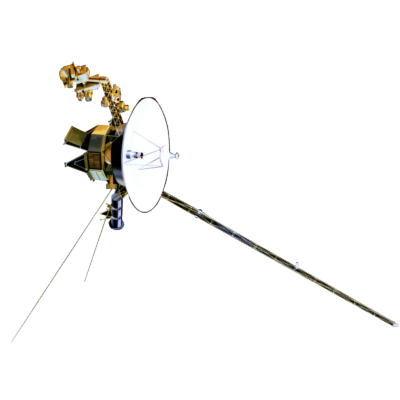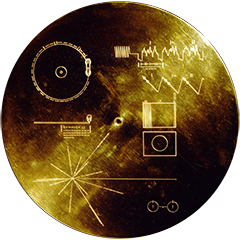Voyager LECP Data Analysis Handbook
Data File Descriptions
Experiment Data Record (EDR) Format Specification
Table C-10, Standard Experiment Data Record Header
| Item | Word | Bits | Description | |||||||||||||||||||||||||||||||||||||||||||||||||||||||||||||||||||||||||||||||||||||||||||||||||||||||||
|---|---|---|---|---|---|---|---|---|---|---|---|---|---|---|---|---|---|---|---|---|---|---|---|---|---|---|---|---|---|---|---|---|---|---|---|---|---|---|---|---|---|---|---|---|---|---|---|---|---|---|---|---|---|---|---|---|---|---|---|---|---|---|---|---|---|---|---|---|---|---|---|---|---|---|---|---|---|---|---|---|---|---|---|---|---|---|---|---|---|---|---|---|---|---|---|---|---|---|---|---|---|---|---|---|---|---|---|---|
| 1 | 1 | 31-8 | Project Identification - Identifies this tape as being written by the MJS77 project. The letters M, J, and S will be written in BCD. | |||||||||||||||||||||||||||||||||||||||||||||||||||||||||||||||||||||||||||||||||||||||||||||||||||||||||
| 2 | 1 | 7-4 | Record Identification -
Identifies which experiment and data subgroup to
which this record pertains.
|
|||||||||||||||||||||||||||||||||||||||||||||||||||||||||||||||||||||||||||||||||||||||||||||||||||||||||
| 3 | 1 | 3-0 | Spacecraft Identification -
Identifies the spacecraft transmitting this data.
|
|||||||||||||||||||||||||||||||||||||||||||||||||||||||||||||||||||||||||||||||||||||||||||||||||||||||||
| 4 | 2 | 31-16 | Physical Record Number - Sequential binary count of all physical records written on this EDR tape. The count is incremented by one after each successful write. This number is initially set to one (1). | |||||||||||||||||||||||||||||||||||||||||||||||||||||||||||||||||||||||||||||||||||||||||||||||||||||||||
| 5 | 2 | 15-8 | Data Mode - Contains
the telemetry format with respect to data content
and data rate.
|
|||||||||||||||||||||||||||||||||||||||||||||||||||||||||||||||||||||||||||||||||||||||||||||||||||||||||
| 6 | 2 | 7-6 | Engineering Extraction Flag -
Identifies whether the engineering data was
extracted out of another data stream or was the
primary data stream.
00 -
stand-alone |
|||||||||||||||||||||||||||||||||||||||||||||||||||||||||||||||||||||||||||||||||||||||||||||||||||||||||
| 7 | 2 | 5 | S/C Playback -
Indicates that the data in this record is Spacecraft
tape recorder playback data.
0 = no This flag is set only for data extracted from PB-1, PB-2, and PB-3 telemetry mode data. |
|||||||||||||||||||||||||||||||||||||||||||||||||||||||||||||||||||||||||||||||||||||||||||||||||||||||||
| 8 | 2 | 4-0 | Spare Starting Earth Received Time - Greenwich Mean Time (GMT) of the first PN bit of the first minor frame (MF) and contained in this record from which this record's prime data is extracted. Binary representation will be used. |
|||||||||||||||||||||||||||||||||||||||||||||||||||||||||||||||||||||||||||||||||||||||||||||||||||||||||
| 9 | 3 | 31-16 | Hour of Current Year - Binary hours since the beginning of the current year. See note following this table. | |||||||||||||||||||||||||||||||||||||||||||||||||||||||||||||||||||||||||||||||||||||||||||||||||||||||||
| 10 | 3 | 15-0 | Seconds of Current Hour - Binary seconds since the beginning of current hour. | |||||||||||||||||||||||||||||||||||||||||||||||||||||||||||||||||||||||||||||||||||||||||||||||||||||||||
| 11 | 4 | 31-16 | Milliseconds of Current Second - Binary milliseconds | |||||||||||||||||||||||||||||||||||||||||||||||||||||||||||||||||||||||||||||||||||||||||||||||||||||||||
| 12 | 4 | 15-8 | Year - Binary year (i.e., 77, 78) | |||||||||||||||||||||||||||||||||||||||||||||||||||||||||||||||||||||||||||||||||||||||||||||||||||||||||
| 13 | 4 | 7-6 | Data Source - Contains
information as to whether the data was derived from
an IDR or Multiple Wide Band data (which indicates
that the data was logged at the station and then
transmitted to JPL from the log tapes).
|
|||||||||||||||||||||||||||||||||||||||||||||||||||||||||||||||||||||||||||||||||||||||||||||||||||||||||
| 14 | 4 | 5-4 | Golay Encoded Flag -
Indicates that the data in this record have been
Golay coded for transmission to Earth and decoded
upon receipt at Earth, so any corrections will be
flagged in the header of this record.
|
|||||||||||||||||||||||||||||||||||||||||||||||||||||||||||||||||||||||||||||||||||||||||||||||||||||||||
| 15 | 4 | 3-0 | Segment Number - Other
than those in the table below are zeros: (Only
pertinent LECP entries are included here.)
|
|||||||||||||||||||||||||||||||||||||||||||||||||||||||||||||||||||||||||||||||||||||||||||||||||||||||||
| 16 | 5 | 31-16 | Hour of Current Year - Binary hours since the beginning of the current year. See note at the end of this table. | |||||||||||||||||||||||||||||||||||||||||||||||||||||||||||||||||||||||||||||||||||||||||||||||||||||||||
| 17 | 5 | 15-0 | Seconds of Current Hour - Binary seconds since the beginning of the current hour. | |||||||||||||||||||||||||||||||||||||||||||||||||||||||||||||||||||||||||||||||||||||||||||||||||||||||||
| 18 | 6 | 31-16 | Millisecond of Current Second - Binary milliseconds. | |||||||||||||||||||||||||||||||||||||||||||||||||||||||||||||||||||||||||||||||||||||||||||||||||||||||||
| 19 | 6 | 15-8 | Year - Binary year (i.e., 77, 78) | |||||||||||||||||||||||||||||||||||||||||||||||||||||||||||||||||||||||||||||||||||||||||||||||||||||||||
| 20 | 6 | 7-0 | Software Version -
contains identification (in binary) of the software
system operating in the computer string which
created the current record. Spacecraft Event Time - Greenwich Mean Time (GMT) that corresponds to the Spacecraft Time of the first MF from which this records prime data was extracted, in binary representation. The format is as follows: |
|||||||||||||||||||||||||||||||||||||||||||||||||||||||||||||||||||||||||||||||||||||||||||||||||||||||||
| 21 | 7 | 31-16 | Hour of Current Year - Binary hours since the beginning of the current year. See note at the end of this table. | |||||||||||||||||||||||||||||||||||||||||||||||||||||||||||||||||||||||||||||||||||||||||||||||||||||||||
| 22 | 7 | 15-0 | Seconds of Current Hour - Binary number of seconds since the beginning of the current hour. | |||||||||||||||||||||||||||||||||||||||||||||||||||||||||||||||||||||||||||||||||||||||||||||||||||||||||
| 23 | 8 | 31-16 | Milliseconds of Current Second - Binary milliseconds | |||||||||||||||||||||||||||||||||||||||||||||||||||||||||||||||||||||||||||||||||||||||||||||||||||||||||
| 24 | 8 | 15-8 | Year - Binary year (i.e., 77, 78) | |||||||||||||||||||||||||||||||||||||||||||||||||||||||||||||||||||||||||||||||||||||||||||||||||||||||||
| 25 | 8 | 7-4 | Spacecraft Event Time Flag - 0=input by NORT file. 1=input by EDR PROC. Either all 0's or all 1's. | |||||||||||||||||||||||||||||||||||||||||||||||||||||||||||||||||||||||||||||||||||||||||||||||||||||||||
| 26 | 8 | 3-0 | FDSC Correction Flag - Indicates that FDSC has been corrected in some manner. (Binary) There is bit for MOD 2, one for MOD 60, and one for line counts also. (1=corrected, 0=OK) 3=Space, 2=MOD 2, 1=MOD 60, 0=L.C. | |||||||||||||||||||||||||||||||||||||||||||||||||||||||||||||||||||||||||||||||||||||||||||||||||||||||||
| 27 | 9 | 31-16 | MJS MOD 216 Count Word - Contains the 16-bit MM subcom time word for this record. Is incremented every 48 minutes. | |||||||||||||||||||||||||||||||||||||||||||||||||||||||||||||||||||||||||||||||||||||||||||||||||||||||||
| 28 | 9 | 15-8 | MJS Mod 60 Count Word - Contains the module 60 spacecraft time as created within the FDS for the first minor frame received that is contained in this record. Increments every 48 seconds. | |||||||||||||||||||||||||||||||||||||||||||||||||||||||||||||||||||||||||||||||||||||||||||||||||||||||||
| 29 | 9 | 7-0 | MJS Line Count Word - Contains the ISS line count which ranges between 1 and 800. Increments every 0.06 second. | |||||||||||||||||||||||||||||||||||||||||||||||||||||||||||||||||||||||||||||||||||||||||||||||||||||||||
| 30 | 10 | 31-24 | ||||||||||||||||||||||||||||||||||||||||||||||||||||||||||||||||||||||||||||||||||||||||||||||||||||||||||
| 31 | 10 | 23-16 | Downlink Telemetry Rate -
contains the rate at which the MJS spacecraft
transmitted the telemetry data to earth (i.e., 40 to
115,200 bits/second). (Binary code)
|
|||||||||||||||||||||||||||||||||||||||||||||||||||||||||||||||||||||||||||||||||||||||||||||||||||||||||
| 32 | 10 | 23-16 |
|
|||||||||||||||||||||||||||||||||||||||||||||||||||||||||||||||||||||||||||||||||||||||||||||||||||||||||
| 33 | 10 | 15-8 | Effective Rate - Contains the effective bit rate of this data within the downlink telemetry rate. (Refer to downlink telemetry rate code.) | |||||||||||||||||||||||||||||||||||||||||||||||||||||||||||||||||||||||||||||||||||||||||||||||||||||||||
| 34 | 10 | 7-0 | FID - Format ID word
used only for Engineering record (extracted from
telemetry data stream).
Bit 0 Spacecraft ID; 1 = FLT 1, 0 = FLT 2 |
|||||||||||||||||||||||||||||||||||||||||||||||||||||||||||||||||||||||||||||||||||||||||||||||||||||||||
| 35 | 11 | 31-24 | Bit Error Tolerance (BET) - Contains the PN bit error tolerance during frame synchronization. (Binary) | |||||||||||||||||||||||||||||||||||||||||||||||||||||||||||||||||||||||||||||||||||||||||||||||||||||||||
| 36 | 11 | 23-16 | DSN Equipment Configuration -
Contains the latest status of any change in station
equipment configuration during the time
corresponding to the first MF received in this
record.
|
|||||||||||||||||||||||||||||||||||||||||||||||||||||||||||||||||||||||||||||||||||||||||||||||||||||||||
| 37 | 11 | 15-0 | Receiver Automatic Gain Control (AGC) - Contains the AGC extracted from the GCF block from which the first minor frame received was derived. (Binary) | |||||||||||||||||||||||||||||||||||||||||||||||||||||||||||||||||||||||||||||||||||||||||||||||||||||||||
| 38 | 12 | 31-24 | DSN Station Number - Contains the identification number of the DSN station originating the data contained in the first minor frame received of this record. (Binary) See page D-12, Item 41. | |||||||||||||||||||||||||||||||||||||||||||||||||||||||||||||||||||||||||||||||||||||||||||||||||||||||||
| 39 | 12 | 23-16 | Spare | |||||||||||||||||||||||||||||||||||||||||||||||||||||||||||||||||||||||||||||||||||||||||||||||||||||||||
| 40 | 12 | 15-0 | Estimated Bit Error Count (EBEC) -
Count of the number of bits in error, looking at the
first 64 bits of each prime MF over N number of
frames. The count resets upon frame time domain or
DSS change. Placed in header on LAD basis.
|
|||||||||||||||||||||||||||||||||||||||||||||||||||||||||||||||||||||||||||||||||||||||||||||||||||||||||
| 41 | 13 | 31-16 | Symbol Signal-to-Noise Ratio (SNR) - Contains the symbol SNR extracted from the GCF block from which the first minor frame received was derived. (Binary) | |||||||||||||||||||||||||||||||||||||||||||||||||||||||||||||||||||||||||||||||||||||||||||||||||||||||||
| 42 | 13 | 15-0 | Decoder SNR - Bit Error Rate out of the Data Decoder Assembly. | |||||||||||||||||||||||||||||||||||||||||||||||||||||||||||||||||||||||||||||||||||||||||||||||||||||||||
| 43 | 14 | 31-16 | Physical Record Number -
A. For individual EDRs: Unused
(set to zeros) |
|||||||||||||||||||||||||||||||||||||||||||||||||||||||||||||||||||||||||||||||||||||||||||||||||||||||||
| 44 | 14 | 15-8 | DQSW - Data Quality Status Word for
MF-1 through MF-30.
Station Lock
Status |
|||||||||||||||||||||||||||||||||||||||||||||||||||||||||||||||||||||||||||||||||||||||||||||||||||||||||
| 44 | 14 | 7-0 | Data Quality Indicators
|
|||||||||||||||||||||||||||||||||||||||||||||||||||||||||||||||||||||||||||||||||||||||||||||||||||||||||
| 45 | 15 | 31-16 | DQSW for MF5-MF12 | |||||||||||||||||||||||||||||||||||||||||||||||||||||||||||||||||||||||||||||||||||||||||||||||||||||||||
| 46 | 15 | 15-0 | DQSW for MF13-MF20 | |||||||||||||||||||||||||||||||||||||||||||||||||||||||||||||||||||||||||||||||||||||||||||||||||||||||||
| 47 | 16 | 31-24 | DQSW for MF21-MF24 | |||||||||||||||||||||||||||||||||||||||||||||||||||||||||||||||||||||||||||||||||||||||||||||||||||||||||
| 48 | 16 | 23-0 | Spare | |||||||||||||||||||||||||||||||||||||||||||||||||||||||||||||||||||||||||||||||||||||||||||||||||||||||||
| 49 | 17-18 | 31-0 | Spare | |||||||||||||||||||||||||||||||||||||||||||||||||||||||||||||||||||||||||||||||||||||||||||||||||||||||||
| 50 | 19 | 31-16 | Spare Data Presence A 4-bit field for data presence indication is supplied for each of the 24 MF to which this header is applied. All 4 bits are set to zero if data is present, otherwise all bits=1. |
|||||||||||||||||||||||||||||||||||||||||||||||||||||||||||||||||||||||||||||||||||||||||||||||||||||||||
| 51 | 19 | 15-12 | DPI for MF 1 | |||||||||||||||||||||||||||||||||||||||||||||||||||||||||||||||||||||||||||||||||||||||||||||||||||||||||
| 52 | 19 | 11-8 | DPI for MF 2 | |||||||||||||||||||||||||||||||||||||||||||||||||||||||||||||||||||||||||||||||||||||||||||||||||||||||||
| 53 | 19 | 7-4 | DPI for MF 3 | |||||||||||||||||||||||||||||||||||||||||||||||||||||||||||||||||||||||||||||||||||||||||||||||||||||||||
| ... | ... | ... | ... | |||||||||||||||||||||||||||||||||||||||||||||||||||||||||||||||||||||||||||||||||||||||||||||||||||||||||
| 72 | 24 | 3-0 | DPI for MF 22 | |||||||||||||||||||||||||||||||||||||||||||||||||||||||||||||||||||||||||||||||||||||||||||||||||||||||||
| 73 | 25 | 31-28 | DPI for MF 23 | |||||||||||||||||||||||||||||||||||||||||||||||||||||||||||||||||||||||||||||||||||||||||||||||||||||||||
| 74 | 25 | 27-24 | DPI for MF 24 | |||||||||||||||||||||||||||||||||||||||||||||||||||||||||||||||||||||||||||||||||||||||||||||||||||||||||
| 75 | 25 | 23-0 | Spare | |||||||||||||||||||||||||||||||||||||||||||||||||||||||||||||||||||||||||||||||||||||||||||||||||||||||||
| 76 | 26-59 | 31-0 | Spare | |||||||||||||||||||||||||||||||||||||||||||||||||||||||||||||||||||||||||||||||||||||||||||||||||||||||||
| 77 | 60 | 31-24 | DRS Data Type - Numbers
are in HEX.
|
|||||||||||||||||||||||||||||||||||||||||||||||||||||||||||||||||||||||||||||||||||||||||||||||||||||||||
| 78 | 60 | 23-0 | Spare | |||||||||||||||||||||||||||||||||||||||||||||||||||||||||||||||||||||||||||||||||||||||||||||||||||||||||
Note: For interpretation of day number and hour of day from hour of year, divide the number of hours by 24. The whole number is the day, the remainder is the hour of that day.
Examples:
36 Hours: 36/24 = 1 Remainder 12 = day 1, hour 12 = Jan. 1, 12 PM
3500 Hours: 3500/24 = 145 Remainder 20 = day 145, hour 20 = May 25, 8 PM
Return to EDR main page.
Return to Data File Descriptions main page.
Return to Voyager
LECP Data Analysis Handbook Table of Contents.
Return to Fundamental
Technologies Home Page.
Updated 8/9/19, Cameron Crane
VOYAGER 1 ELAPSED TIME
*Since official launch
September 5, 1977, 12:56:00:00 UTC
VOYAGER 2 ELAPSED TIME
*Since official launch
August 20, 1977, 14:29:00:00 UTC
QUICK FACTS
Mission Duration: 40+ years have elapsed for both Voyager 1 and Voyager 2 (both are ongoing).
Destination: Their original destinations were Saturn and Jupiter. Their current destination is interstellar space.



